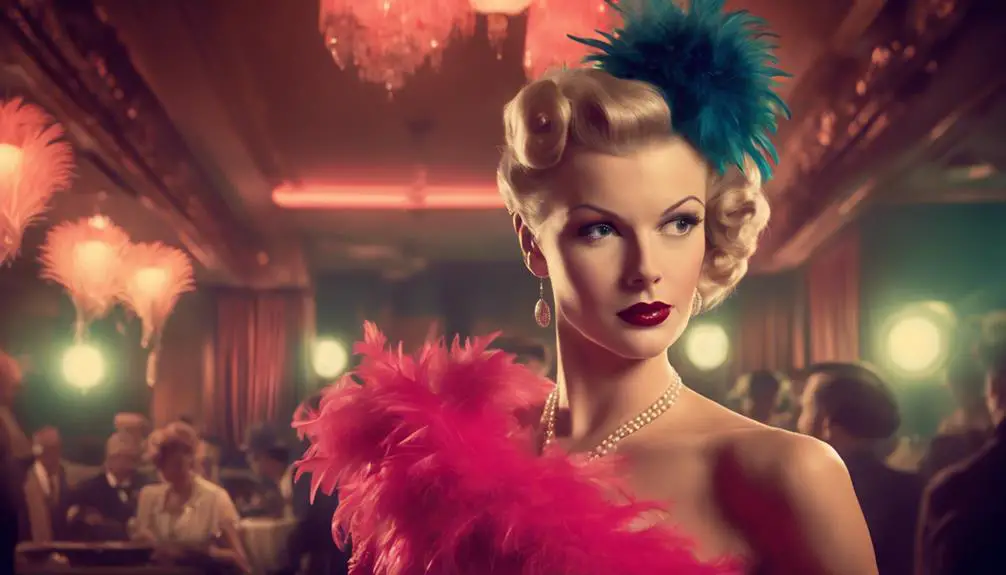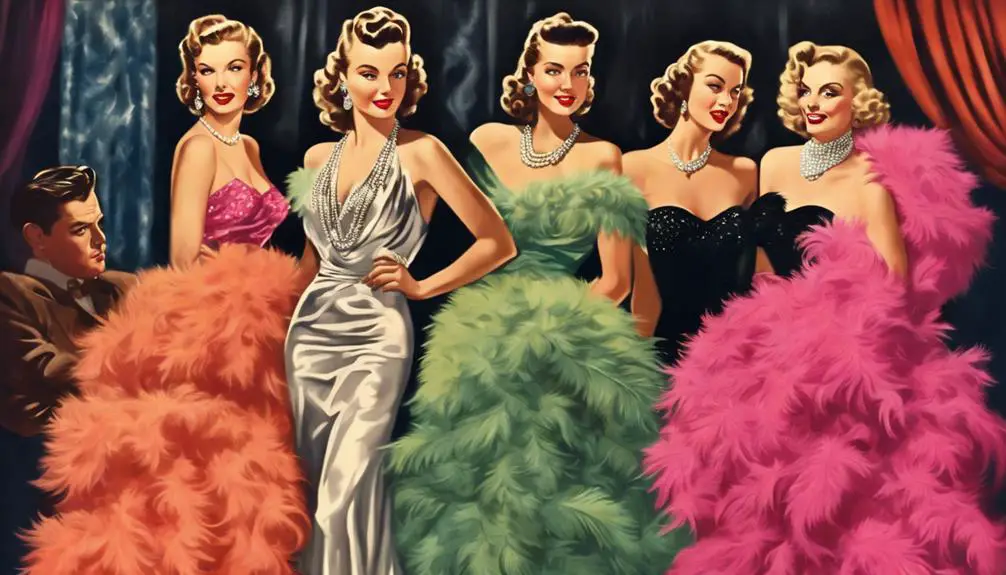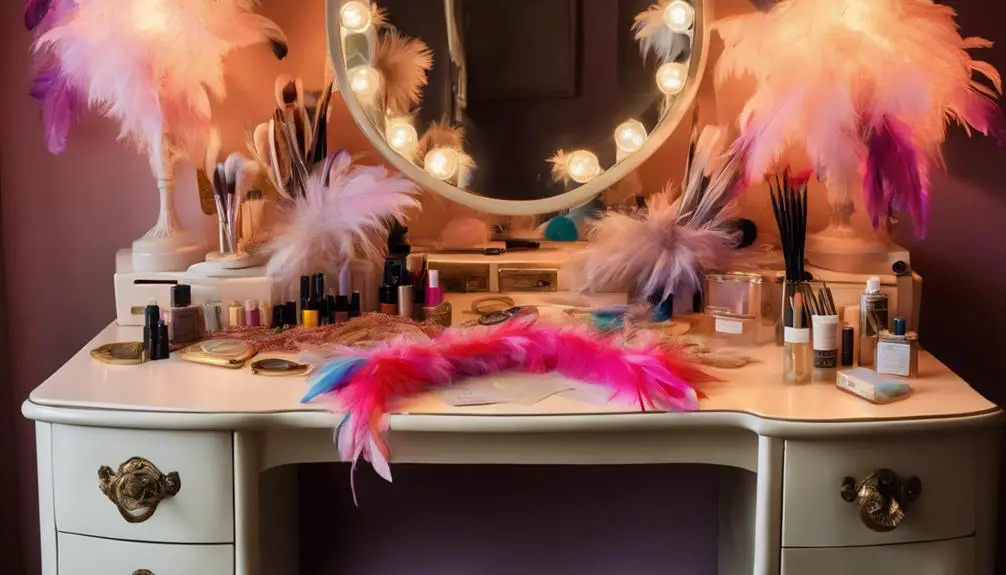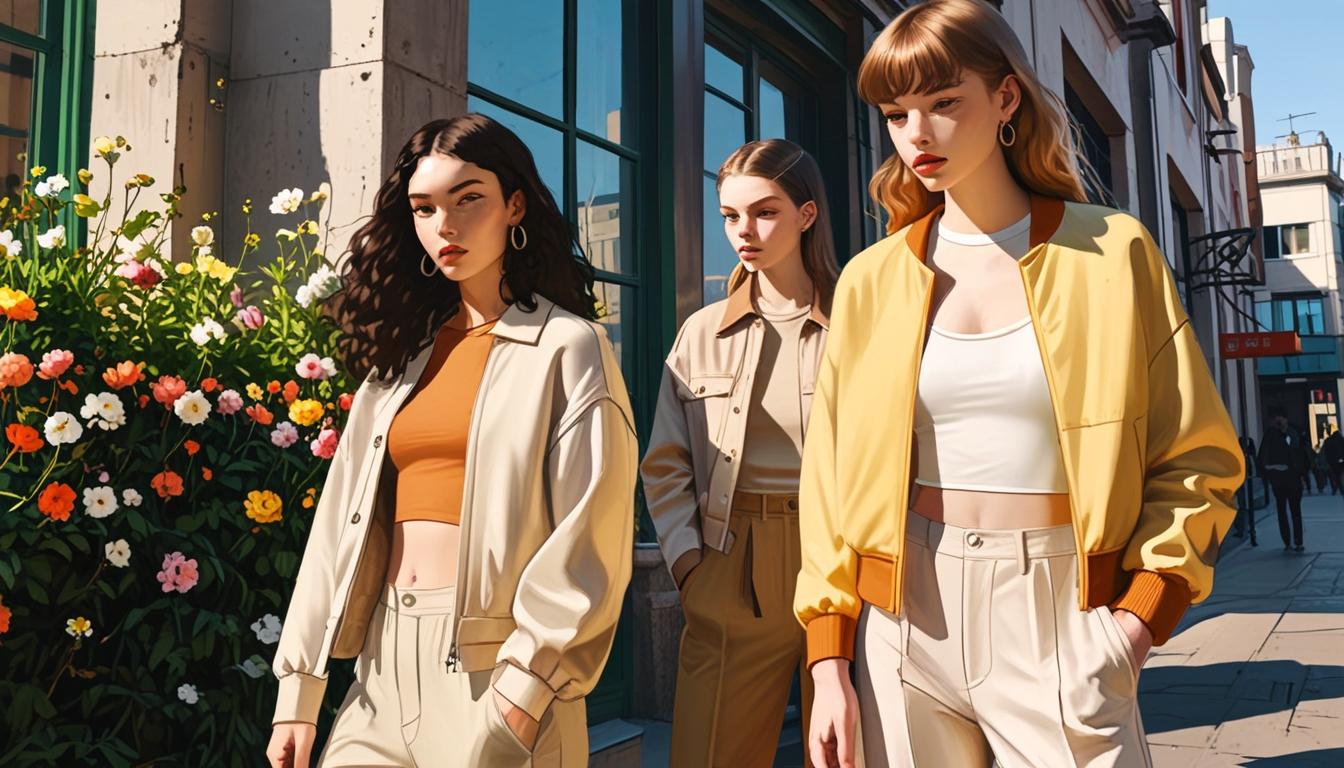In the 1940s, women's feather boas became iconic symbols of femininity and glamour, representing a cultural shift towards elegance amidst wartime austerity. As Hollywood starlets like Rita Hayworth and Veronica Lake donned these luxurious accessories, boas reflected a yearning for personal expression and beauty. The era's fashion embraced bold colors and sophisticated styles, with feather boas enhancing outfits in both everyday life and pin-up imagery. This enchanting accessory laid the groundwork for timeless fashion relevance. Understanding their historical significance and care can enrich your appreciation of these glamorous pieces. You might find more about their enduring impact intriguing.
Historical Significance of Feather Boas

In the glamorous world of the 1940s, feather boas emerged as a striking symbol of femininity and allure, enchanting both the public and the fashion industry. During this era, marked by the shadow of World War II, the feather boa represented an essential form of escapism. You'd see Hollywood starlets donning these luxurious accessories to elevate their on-screen presence, forging a connection between glamour and empowerment.
The popularity of feather boas signified a cultural shift from the utilitarian styles born of wartime restrictions to an emphasis on elegance and personal expression. You can almost picture the glamorous portraits of the time, where actresses adorned in feather boas not only enhanced their beauty but also redefined femininity. This accessory became synonymous with the ideals of sophistication, showcasing a woman's desire to embrace her identity amidst the chaos of the world.
Moreover, the impact of feather boas extended far beyond the 1940s, laying the groundwork for their timeless relevance in fashion and popular culture. You see echoes of this glamorous accessory in later decades, proving that the feather boa is not just a relic but a lasting symbol of charm and allure.
Fashion Trends of the 1940s
The fashion landscape of the 1940s, marked by a blend of wartime practicality and post-war glamour, showcased a unique transformation in women's style. During this decade, you'd notice how designs emerged from the constraints of wartime austerity, prioritizing both elegance and femininity. High-waisted skirts and tailored blouses became staples, allowing for a flattering silhouette while remaining functional. The emergence of vintage clothing trends, particularly the incorporation of accessories like feather boas, reflected a growing desire for personal expression and identity in fashion, as seen in vintage clothing labels.
Luxurious fabrics like silk and velvet made their way back into women's wardrobes, elevating everyday attire. Accessories, particularly feather boas, played a vital role in this fashion narrative, serving as symbols of glamour and femininity. You might have seen these boas adorning women in Hollywood films, capturing the essence of escapism that many sought during trying times.
Bold colors and patterns contrasted with the more subdued tones of wartime clothing, allowing for personal expression through fashion. The rise of pin-up culture further popularized this trend, as glamorous portraits frequently featured women draped in feather boas, celebrating the allure of femininity. Overall, the 1940s was a decade of resilience and transformation, where fashion became an empowering statement amidst societal changes.
Iconic Celebrities and Their Styles

As fashion evolved in the 1940s, iconic celebrities became the embodiment of style, often elevating the trends of the time with their personal flair. Rita Hayworth, for instance, frequently showcased feather boas in her films, which symbolized the glamour and femininity that defined Hollywood. Her presence on screen made the feather boa synonymous with allure, enchanting audiences and setting a standard for elegance.
Veronica Lake, with her sultry looks, complemented her signature hairstyle with feather boas, enhancing her mystique. Meanwhile, Marlene Dietrich utilized these accessories to exude sophistication and confidence, solidifying her status as a fashion icon.
The allure of feather boas extended to pin-up photography, where artists like Alberto Vargas captured the era's idealization of feminine beauty and sensuality. Furthermore, celebrities such as Lana Turner and Hedy Lamarr embraced feather boas at public appearances and red carpet events, further cementing their status as style icons of the time.
In this way, feather boas transcended mere fashion accessories, becoming essential elements of identity for these stars, reflecting the glamour and confidence that characterized the 1940s.
Cultural Impact of Glamour
Capturing the essence of femininity and allure, the glamour of the 1940s left an indelible mark on cultural ideals, particularly through the lens of Hollywood. Film stars like Rita Hayworth and Veronica Lake not only set fashion trends but also transformed the feather boa into a potent symbol of elegance and sophistication. Amid wartime austerity, women embraced this accessory as a means of escapism, reflecting the cultural zeitgeist and the desire for beauty during challenging times.
Feather boas became synonymous with the pin-up culture, enhancing the allure of women in portraits and fashion photography. The dramatic lighting and styling used in these images emphasized confidence, reinforcing societal ideals of femininity. As you look back, you can see how these accessories elevated outfits, serving as essential props in popular media, thereby solidifying their status as must-have items for any glamorous portrayal.
The glamour of the 1940s established a lasting cultural impact, influencing future fashion movements. Today, the feather boa remains a timeless emblem of elegance and theatricality, echoing the era's ideals and continuing to inspire generations with its rich history.
Care and Maintenance Tips

A feather boa's allure can quickly fade without proper care, making maintenance essential for preserving its beauty. To guarantee your boa remains a stunning accessory, follow these care tips:
| Tip | Action | Reason |
|---|---|---|
| Store Properly | Keep it in a cool, dry place | Prevents damage and maintains shape |
| Avoid Sunlight | Don't expose it to direct sunlight | Protects colors from fading and feathers from becoming brittle |
| Shake or Steam | Gently shake or use steam occasionally | Removes dust and restores volume |
| Clean with Care | Use a soft brush and avoid harsh chemicals | Preserves the material's integrity |
Frequently Asked Questions
When Did the Feather Boa Come Out?
The feather boa emerged in the early 20th century, gaining traction in luxury salons and theatrical performances. It quickly became a symbol of femininity, evolving through various fashion trends and cultural movements over the decades.
What Actress Has a Feather Boa?
You might think of Marilyn Monroe, who famously donned a feather boa, enchanting audiences with her charm. Similarly, Rita Hayworth and Bette Davis showcased this glamorous accessory, enhancing their allure and solidifying its iconic status.
Who Wore Feather Boas?
You'll find feather boas worn by various performers, socialites, and fashion enthusiasts throughout history. Their allure draws attention, enhancing elegance and femininity, making them a enchanting accessory in theatrical performances, parties, and glamorous events alike.
Did Flappers Wear Feather Boas?
Yes, flappers wore feather boas as bold fashion statements. These accessories accentuated their outfits, symbolizing the era's liberation and femininity. You'll find that flappers embraced this glamorous touch, enhancing their distinctive, rebellious style.



